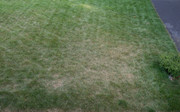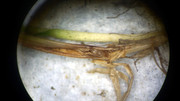Kentucky bluegrass, Fescue, Rye and Bent, etc
-
Jeff508
- Posts: 198
- Joined: April 18th, 2012, 1:06 am
- Location: Boston Surburb
- Grass Type: KBG, Northern Mix
- Lawn Size: Not Specified
- Level: Not Specified
Post
by Jeff508 » June 23rd, 2016, 10:09 pm
I don't know how common this is but in addition to grubs, fungus, drought, etc., add this one to the list. This photo might look like a lawn in need of water, or a fungal disease? I am fairly sure this one is caused by some larvae inside grass stems.

Here is my old thread on this topic from 2012.
http://aroundtheyard.com/northern/anoth ... t8002.html
I haven't done anything about it since 2012 and this year, the damage is much worse. So I took 3 samples of sick-looking grass stems and dissected them and sure enough, 3 out of 3, this is what's inside. Unlike the pictures in my 2012 posts, the pest is in the egg stage(?) and not wiggling around.

I wanted to share this with others here. So when your grass is turning brown, you have one more possibility to think about.
-
TimmyG
- Posts: 2244
- Joined: May 15th, 2012, 6:04 pm
- Location: Dracut, MA
- Grass Type: Northern Mix
- Lawn Size: 20000-1 acre
- Level: Experienced
Post
by TimmyG » June 23rd, 2016, 10:49 pm
Aww, I thought I was going to be the first to suggest frit fly based on the appearance of the larva in your 2012 thread, but then I saw in your very last post there that the OSU prof/entomologist identified an adult fly as a frit fly.
-
Jeff508
- Posts: 198
- Joined: April 18th, 2012, 1:06 am
- Location: Boston Surburb
- Grass Type: KBG, Northern Mix
- Lawn Size: Not Specified
- Level: Not Specified
Post
by Jeff508 » June 23rd, 2016, 11:23 pm
Timmy, you are good! It probably is. I do see swarms of little flies a few different times a year when mowing the lawn so that's another supporting evidence. Umass guys couldn't identity it so they posted the question to some professional forum and a professor from OSU suggested it.
Looking at the lawn picture, most guys would say "drought stress".
-
ken-n-nancy
- Posts: 2571
- Joined: July 17th, 2014, 3:58 pm
- Location: Bedford, NH
- Grass Type: Front: KBG (Bewitched+Prosperity); Side: Bewitched KBG; Back: Fine Fescue Blend + Prosperity
- Lawn Size: 10000-20000
- Level: Experienced
Post
by ken-n-nancy » June 24th, 2016, 8:12 am
Wow, definitely looked like drought stress to me. Haven't heard of "frit fly" before. Any suggestions on what to do about it? Does imidacloprid address it?
Wonder if I need to start dissecting grass in an area that I thought was drought stressed in my lawn...
-
Jeff508
- Posts: 198
- Joined: April 18th, 2012, 1:06 am
- Location: Boston Surburb
- Grass Type: KBG, Northern Mix
- Lawn Size: Not Specified
- Level: Not Specified
Post
by Jeff508 » June 24th, 2016, 4:55 pm
I don't know what the best treatment is. Back in 2012, I sprayed Bayer Complete Insect Killer which has β-cyfluthrin and Imidacloprid and it seemed to have worked as I recall. I haven't used any insecticides since then, although this problem has been getting worse each year. I try to avoid using chemicals but I may have to use it now.
Between insect problems and fungal problems, which I do get sometimes, it's a tough battle. My neighbors who blindly use the 4-step program with fungicide seem to do better sometimes, at least those who water and mow properly.
-
TimmyG
- Posts: 2244
- Joined: May 15th, 2012, 6:04 pm
- Location: Dracut, MA
- Grass Type: Northern Mix
- Lawn Size: 20000-1 acre
- Level: Experienced
Post
by TimmyG » June 24th, 2016, 10:23 pm
Below is the page that I read about the flit fly. It's from the same site from which someone shared info on billbugs in the 2012 thread.
Frit Fly
Regarding larval frit fly control, it states, "At present, few contact insecticides can reach the interior of infested plants that are hosting frit fly maggots. Use of an insecticide with systemic action is usually a better choice."
Imidacloprid would probably fit the bill, then.
-
Jeff508
- Posts: 198
- Joined: April 18th, 2012, 1:06 am
- Location: Boston Surburb
- Grass Type: KBG, Northern Mix
- Lawn Size: Not Specified
- Level: Not Specified
Post
by Jeff508 » July 16th, 2016, 6:01 pm
Bayer Complete Insect Killer which has Imidacloprid, does seem to work. I am not sure if there are better ones out there.
The mystery that goes back many years has been solved in my case. Every year, I did not know why my lawn turned partially brown starting in late June. In addition to dead patches, there was a high percentage of dead blades mixed in throughout - perfectly fitting the description of BBDL. In my case, this BBDL is caused by this frit fly larvae. There must be thousands of them. A very easy way to identify is to lightly pull a dead brown blade and it will break off just above the soil level and there will be a rot at the base where a larva was. You may also see a partial small round hole.
From what I have read, frit flys go through several reproductive cycles a season so I probably have to use the chemicals multiple times.
-
ken-n-nancy
- Posts: 2571
- Joined: July 17th, 2014, 3:58 pm
- Location: Bedford, NH
- Grass Type: Front: KBG (Bewitched+Prosperity); Side: Bewitched KBG; Back: Fine Fescue Blend + Prosperity
- Lawn Size: 10000-20000
- Level: Experienced
Post
by ken-n-nancy » July 17th, 2016, 9:28 am
Glad to hear that you have a solution -- hopefully a few applications of imidacloprid at the right times will break the cycle for you!
-
oze
- Posts: 883
- Joined: September 12th, 2014, 1:56 pm
- Location: Fort Wayne, Indiana 46804
- Grass Type: Northern mix transitioning to Regenerating Perennial Ryegrass
- Lawn Size: 3000-5000
- Level: Some Experience
Post
by oze » July 17th, 2016, 9:47 am
Oh great, another lawn pest for me to obsess about and to misdiagnose resultant damage.

-
Green
- Posts: 6838
- Joined: September 14th, 2012, 10:53 pm
- Location: CT (Zone 6B)
- Grass Type: KBG, TTTF, TTPR, and FF (various mixtures)
- Lawn Size: 10000-20000
- Level: Experienced
Post
by Green » July 17th, 2016, 9:32 pm
Wow, this is crazy. I hope that's not what my brown stems are due to! Most of it's evenly distributed. Lately I have another mystery too...a few small, well-defined patches that look like dog urine spots. Maybe a wild animal is peeing on the grass. No dog has been near it that I know. But I hope I don't have these flies!
-
Green
- Posts: 6838
- Joined: September 14th, 2012, 10:53 pm
- Location: CT (Zone 6B)
- Grass Type: KBG, TTTF, TTPR, and FF (various mixtures)
- Lawn Size: 10000-20000
- Level: Experienced
Post
by Green » July 18th, 2016, 9:53 pm
Cut open some stems with a razor blade today. Thankfully, didn't observe anything like that. All I found was a tiny snail shell near one of the stems, on the outside.
-
JHazzardB
- Posts: 417
- Joined: August 7th, 2012, 11:16 am
- Location: OKC, OK
- Grass Type: Front Yard: KBG blend. Back Bewitched/Nuglade
- Lawn Size: 5000-10000
- Level: Experienced
Post
by JHazzardB » July 19th, 2016, 1:45 pm
This is the most miniaturized version of an easter egg hunt i've ever seen.
-
Jeff508
- Posts: 198
- Joined: April 18th, 2012, 1:06 am
- Location: Boston Surburb
- Grass Type: KBG, Northern Mix
- Lawn Size: Not Specified
- Level: Not Specified
Post
by Jeff508 » July 25th, 2016, 4:41 pm
Green,
I think it's long past the larval stage now so you wouldn't find any. Now, I only see the remnant of the damage they have done.
You can barely see a decayed hole near the bottom of the top blade.
The bottom blade shows rotted grass stem where a larva lived. You can see some frass left behind.

Who is online
Users browsing this forum: No registered users and 7 guests


